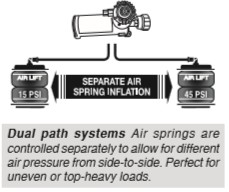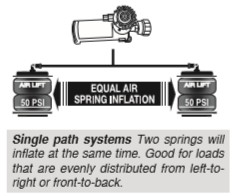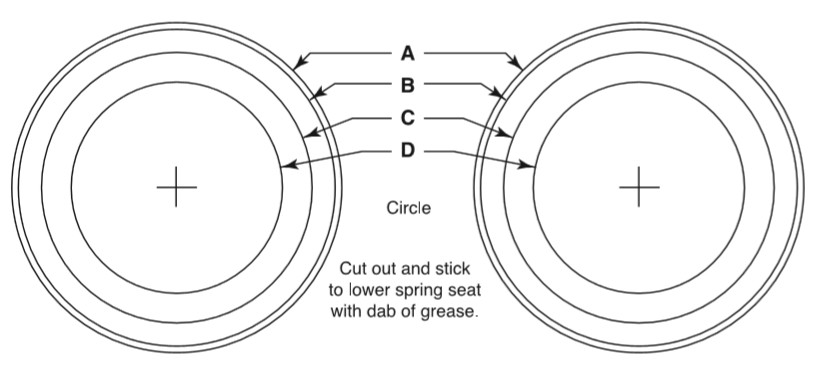
How to Install Air Lift Performance 1000 Air Spring Kit (79-04 All) on your Ford Mustang
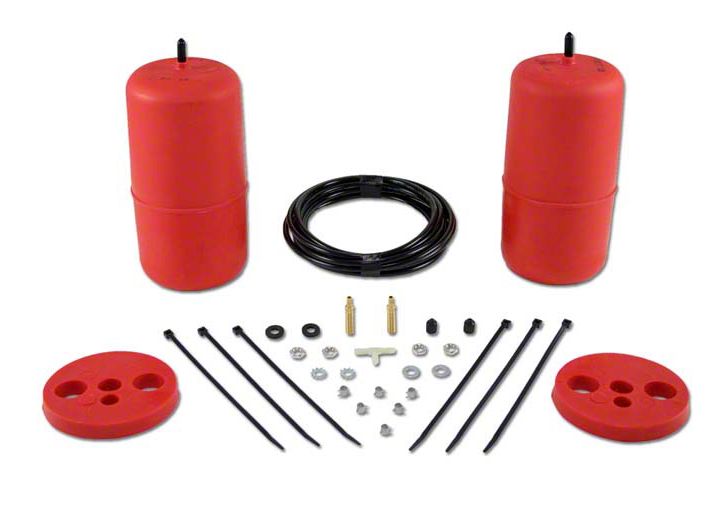
Shop Parts in this Guide
HARDWARE LIST
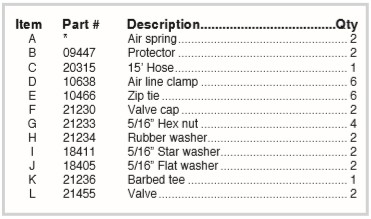
Installing the Air Lift 1000 System
IMPORTANT NOTE
This kit fits many different vehicles. Please consult the following listings for the appropriate installation section for your particular vehicle.
Section A: General Motors A (Century, Celebrity, Cutlass Cierra 6000) and X (Skylark, Citation, Omega, Phoenix) front wheel drive, with solid rear axle cars; Ford, Lincoln, Mercury full size and mid-size cars; Chevy Lumina APV, Olds Silhouette, and Pontiac Transport; Nissan Pathfinder; Isuzu Trooper, Amigo, and Vehicross
Section B: Camaro, Firebird, Monza, Skyhawk, Starefire, Astre, Sunbird, and Vega
Section C: General Motors E (Toronado, Riviera, El Dorado, SeVille) and H (LeSabre, Electra, Park Ave, DeVille, Eighty-Eight, Ninety-Eight, and Bonneville) Cars; Kia Sedona Van; Nissan Morano, Toyota Scion XB.
SECTION A INSTALLATION
1. Some Ford, Lincoln, and Mercury models come equipped with a rubber sleeve inside of the rear coil springs. This needs to be removed prior to proceeding with the installation. It can either be cut out or pulled out with vise grips.
2. Jack up the rear of the vehicle or raise on a hoist. Support the frame with safety stands. Lower the axle or raise the body of the vehicle until the suspension is fully extended (fig. 1).
3. If necessary, additional clearance between the coil may be obtained by removing the shock absorbers from the lower mountings and lowering the suspension an additional two inches.
OBSERVE THE TENSION ON THE BRAKE LINE. DO NOT STRAIN.
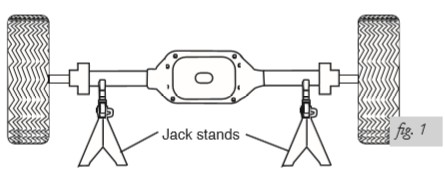
4. Remove the plastic cap from the barbed stem on the end of the air spring and exhaust all the air from the air spring by rolling it up towards the barbed stem. Replace the cap so that the air spring holds its flat shape. Form the air spring into a hot dog bun shape (fig. 2).
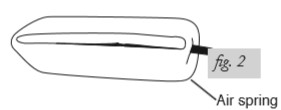
5. Insert the stem end of the air spring into the lowest opening of the coil (valve stem up). Push the air spring into the coil spring by hand or with a blunt object such as a spoon- type tire iron (fig. 3).
6. When the air spring is completely within the coil, remove the cap and allow the air spring to assume its original shape.
7. Push the air spring to the bottom of the coil and insert the protector on top of the air spring (fig. 4).
8. Continue with “Installing the Air Line.”
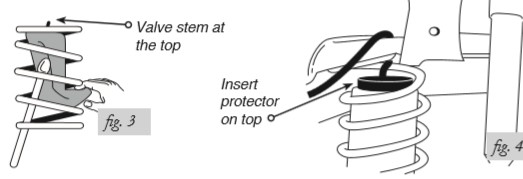
SECTION B INSTALLATION
1. Jack up the rear of the vehicle or raise on a hoist. Support the frame with safety stands (see fig. 1).
2. Detach the shock absorber lower ends from the axle. Lower the axle or raise the body to permit the removal of the coil spring.
3. 1975 and up Vega, Monza, Starfire, Skyhawk, and Sunbird only:
a. Remove the upper bound bumper/cone assembly with coil spring (fig. 5). The bumper/cone assembly will not be reused, as the air spring replaces its function.
b. Cut out circle “C” on the template (see Template on page 11) and place onto the lower spring seat, holding it in position with a dab of grease. Center punch and drill a 1/2” hole in the marked location (fig. 6).

4. Insert the air spring into the coil with the stem down (fig. 7).
5. If removed, place the upper spring insulator on top of the coil spring. Index it so that the notch fits on the end of the spring.
6. Replace the coil springs and air spring assembly into the vehicle spring seats, insuring that the end of the spring is indexed properly into the notch in the seat.
7. Push the air spring to the top of the coil spring and insert the protector on top of the lower spring seat (fig. 8).
8. Continue with “Installing the Air Line.”
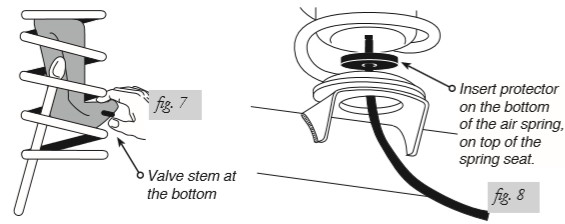
SECTION C INSTALLATION
1. Jack up the rear of the vehicle or raise on a hoist. Support the frame with safety stands. Lower the axle or raise body of the vehicle until the suspension is fully extended (see fig. 1).
2. Some of the vehicles in this section do not have a hole in the lower spring. Cut out circle “D” on the template and place into the lower spring seat, holding it in place with a dab of grease. Center punch and drill a 3/4” hole in the marked location.
3. Remove the plastic cap from the barbed stem on the end of the air spring and exhaust all the air from the air spring by rolling it up towards the barbed stem. Replace the cap so that the air spring holds its flat shape. Form the air spring into a hot dog bun shape.
4. Insert the air spring into the coil with the stem down. Push the air spring into the coil spring by hand or carefully with a blunt object such as a spoon-type tire iron (see fig. 7).
5. When the air spring is completely within the coil, remove the cap and allow it to assume its original shape.
6. Push the air spring to the top of the coil and insert the protector on the bottom of the air spring (see fig. 8).
7. Continue with “Installing the Air Line.”
INSTALLING THE AIR LINE
Tee air line installation is recommended unless weight in the vehicle varies from one side to the other and unequal pressures are needed to level the load. Dual air lines are used in this case.
TEE AIR LINE ROUTING
TO PREVENT THE AIR LINE FROM MELTING, MAINTAIN AT LEAST 8” FROM THE EXHAUST SYSTEM TO THE AIR LINE.
1. Locate the desired tee location on the frame rail or cross member. Determine and cut adequate length of air line to reach from tee to the left and right side air springs.
LEAVE SUFFICIENT AIR LINE SLACK TO PREVENT ANY STRAIN ON THE FITTING DURING AXLE MOTIONS.
2. Slide an air line clamp onto the air line.
3. Push the air line over one side of the tee until all the barbs are covered. With a pair of pliers, slide the air line clamp forward until it fully covers the barbed section. Repeat entire procedure for other leg of the tee (fig. 9).
4. Route the air line along the cross member and either the lower control arm or the upper spring seat to the air spring.
5. Insert the air line through the spring seat and protectors.
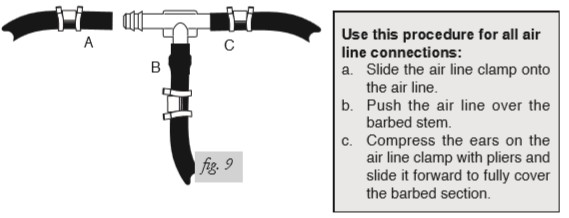
6. Push the air line onto the stem, covering all the barbs (fig. 10). With the pliers, slide the air line clamp upward until it fully covers the barbed section.
7. Push the remaining air line over the last fitting on the tee and route it along the frame to the desired inflation valve location. Attach the air line with plastic straps or wire.
8. Select a location for the inflation valve in the gas cap well, the trunk, rear bumper, fender flange or behind license plate, insuring that the valve will be protected and accessible with an air hose (fig. 11).
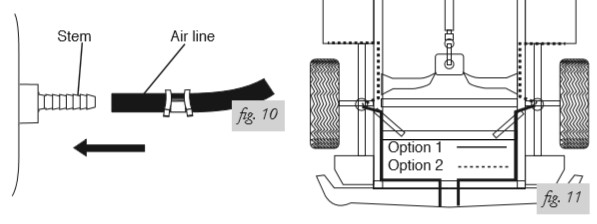
9. Drill a 5/16” hole for the inflation valve and mount as shown (fig. 12). The rubber washer serves as an outside weather seal.
10. Slide the air line clamp over the air line. Push the air line onto the fitting covering all barbs. Using pliers, slide the air line clamp forward until it fully covers the barbed section (fig. 13).
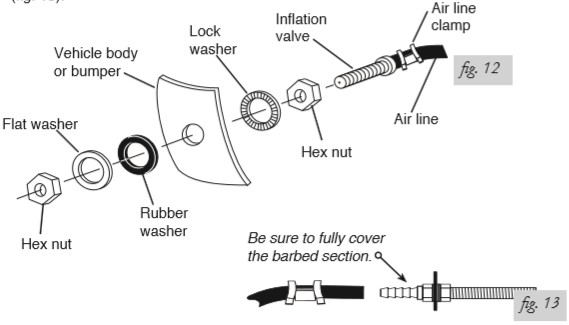
11. Raise the axle or lower the vehicle body until the air springs lightly touch the upper spring seat and lower spacers.
12. Check tail pipe clearance and insure that it is at least 2-3 inches from air spring. If necessary, loosen clamps and rotate or move to obtain additional clearance. If heat shield is provided, install. Attach shock absorbers if removed earlier in the installation.
DO NOT INFLATE AIR SPRINGS BEFORE READING THE MAINTENANCE AND OPERATION SECTION.
13. Continue to “Checking for Leaks”.
DUAL AIR LINE ROUTING
TO PREVENT AIR LINE FROM MELTING, KEEP IT AT LEAST 8” FROM EXHAUST SYSTEM.
1. Select a location for the inflation valves in the rocker panel flange, or rear bumper, assuring that each valve will be protected and accessible with an air hose.
2. Determine and cut adequate length of air line to reach from valve location to left side air spring.
LEAVE SUFFICIENT AIR LINE SLACK TO PREVENT ANY STRAIN ON FITTING DURING AXLE MOTIONS.
3. Insert the air line through the spring seat and protectors.
4. Slide air clamp onto the cut air line.
5. Push the air line onto the stem, covering all the barbed section (see fig. 10). With pliers slide the air line clamp forward until it fully covers barbed section.
6. Repeat process for right side.
7. Drill a 5/16” hole for inflating valves and mount as illustrated. Rubber washer is for outside weather seal (see fig. 12).
8. Route air line along control arm and frame to inflation valve location and cut off excess.
9. Slide a clamp onto the air line and push the air line over the fitting, covering all the barbs. With pliers slide the air line clamp forward until if fully covers the barbed section (see fig. 13).
10. Raise axle or lower body until air springs lightly touch the upper/lower spring seat and protectors.
11. Check tail pipe clearance and insure that it is at least 2-3 inches from air springs. If necessary, loosen clamps and rotate or move to obtain additional clearance. If heat shields are supplied, install them. Attach shock absorbers if removed earlier in the installation.
DO NOT INFLATE AIR SPRINGS BEFORE READING THE MAINTENANCE AND OPERATION SECTION.
CHECKING FOR LEAKS
1. Inflate the air spring to 35 PSI.
2. Spray all connections and the inflation valves with a solution of 1/5 liquid dish soap and 4/5 water. Spot leaks easily by looking for bubbles in the soapy water.
3. After the test, deflate the springs to the minimum pressure required to restore the system to normal ride height. Do not deflate to lower than 5 PSI.
4. Check the air pressure again after 24 hours. A 2 - 4 PSI loss after initial installation is normal. Retest for leaks if the loss is more than 5 lbs.
FIXING LEAKS
1. If there is a problem with the inflation valve:
a. Check the valve core by tightening it with a valve core tool.
b. Check the air line by removing the air line from the barbed type fitting. Cut the air line off a few inches in front of the fitting and use a pair of pliers or vice grips to pull/ twist the air line off of the fitting.
DO NOT CUT OFF THE AIR LINE COMPLETELY AS THIS WILL USUALLY NICK THE BARB AND RENDER THE FITTING USELESS.
2. If the preceding steps have not resolved the problem, call Air Lift customer service at (800) 248-0892.
Before Operating
INSTALLATION CHECKLIST
Clearance test — Inflate the air springs to 35 PSI and make sure there is at least ½” clearance from anything that might rub against each cylinder. Be sure to check the tire, brake drum, frame, shock absorbers and brake cables.
Leak test before road test — Inflate the air springs to 30 PSI and check all connections for leaks. All leaks must be eliminated before the vehicle is road tested.
Heat test — Be sure there is sufficient clearance from heat sources, at least 6” for air springs and air lines. If a heat shield was included in the kit, install it. If there is no heat shield, but one is required, call Air Lift customer service at (800) 248-0892.
Fastener test — Recheck all bolts for proper torque.
Road test — The vehicle should be road tested after the preceding tests. Inflate the springs to 25 PSI. Drive the vehicle 10 miles and recheck for clearance, loose fasteners and air leaks.
Operating instructions — If professionally installed, the installer should review the operating instructions with the owner. Be sure to provide the owner with all of the paperwork that came with the kit.
POST-INSTALLATION CHECKLIST
Overnight leak down test — Recheck air pressure after the vehicle has been used for 24 hours. If the pressure has dropped more than 5 PSI, then there is a leak that must be fixed. Either fix the leak yourself or return to the installer for service.
Air pressure requirements — I understand the air pressure requirements of my air spring system. Regardless of load, the air pressure should always be adjusted to maintain ride height at all times.
Thirty day or 500 mile test — I understand that I must recheck the air spring system after 30 days or 500 miles, whichever comes first. If any part shows signs of rubbing or abrasion, the source should be identified and moved, if possible. If it is not possible to relocate the cause of the abrasion, the air spring may need to be remounted. If professionally installed, the installer should be consulted. Check all fasteners for tightness.
Product Use, Maintenance and Servicing

MAINTENANCE GUIDELINES
NOTE By following these steps, vehicle owners will obtain the longest life and best results from their air spring.
1. Check the air pressure weekly.
2. Always maintain normal ride height. Never inflate beyond 35 PSI.
3. If you develop an air leak in the system, use a soapy water solution to check all air line connections and the inflation valve core, before deflating and removing the spring.
4. When increasing load, always adjust the air pressure to maintain normal ride height. Increase or decrease pressure from the system as necessary to attain normal ride height for optimal ride and handling. Remember that loads carried behind the axle (including tongue loads) require more leveling force (pressure) than those carried directly over the axle.
FOR YOUR SAFETY AND TO PREVENT DAMAGE TO YOUR VEHICLE, DO NOT ExCEED MAxIMUM GROSS VEHICLE WEIGHT RATING (GVWR), AS INDICATED BY THE VEHICLE MANUFACTURER. ALTHOUGH YOUR AIR SPRINGS ARE RATED AT A MAxIMUM INFLATION PRESSURE OF 35 PSI, THE AIR PRESSURE ACTUALLY NEEDED IS DEPENDENT ON YOUR LOAD AND GVWR.
5. Always add air to the springs in small quantities, checking the pressure frequently. Cylinders require less air volume than a tire and inflate quickly.
6. Should it become necessary to raise the vehicle by the frame, make sure the system is at a minimum pressure (5 PSI) to reduce tension on the suspension/brake components. Use of on-board leveling systems do not require deflation or disconnection.
OPERATING TIPS
1. Inflate your air springs to 35 PSI before adding the payload. This will allow the air cylinder to properly mesh with the coil spring. After the vehicle is loaded, adjust your air pressure down to level the vehicle and for ride comfort.
2. When carrying a payload it will be helpful to increase the tire inflation pressure in proportion to any overload condition. We recommend a 2 PSI increase above normal for each 100 lbs additional load on the axle.
Troubleshooting Guide
1. Leak test the air line connections, the threaded connection into the air spring, and all fittings in the control system.
2. Inspect the air lines to be sure none are pinched. Tie straps may be too tight. Loosen or replace the strap and replace leaking components.
3. Inspect the air line for holes and cracks. Replace as needed.
4. Look for a kink or fold in the air line. Reroute as needed. If the preceding steps do not solve the problem, it is possibly caused by a failed air spring — either a factory defect or an operating problem. Please call Air Lift at (800) 248-0892 for assistance.
Tuning the Air Pressure
Pressure determination comes down to three things — level vehicle, ride comfort, and stability.
1. Level vehicle
If the vehicle’s headlights are shining into the trees or the vehicle is leaning to one side, then it is not level (fi g. 16). Raise the air pressure to correct either of these problems and level the vehicle.
2. Ride comfort
If the vehicle has a rough or harsh ride it may be due to either too much pressure or not enough (fi g. 17). Try different pressures to determine the best ride comfort.
3. Stability
Stability translates into safety and should be the priority, meaning the driver may need to sacrifi ce a perfectly level and comfortable ride. Stability issues include roll control, bounce, dive during braking and sponginess (fi g. 18). Tuning out these problems usually requires an increase in pressure.

Guidelines for Adding Air
1. Start with the vehicle level or slightly above.
2. When in doubt, always add air.
3. For motorhomes, start with 50-100 PSI in the rear because it can be safely assumed that it is heavily loaded.
4. If the front of the vehicle dives while braking, increase the pressure in the front air bags, if equipped.
5. If it is ever suspected that the air bags have bottomed out, increase the pressure (fig. 19).
6. Adjust the pressure up and down to find the best ride.
7. If the vehicle rocks and rolls, adjust the air pressure to reduce movement.
8. It may be necessary to maintain different pressures on each side of the vehicle. Loads such as water, fuel, and appliances will cause the vehicle to be heavier on one side (fig. 20). As much as a 50 PSI difference is not uncommon

Choosing the Right On-Board Air Compressor System
Add an on-board air compressor sytem to inflate and deflate your air springs with the touch of a button — from inside or outside of the vehicle .
• For convenient, on-the-go control of your air springs, add an Air Lift on-board air compressor system.
• Air Lift on-board air compressor systems eliminate the search for gas stations that have a working compressor, saving you time, energy and money.
• All systems include a compressor, controller and all parts needed for easy installation.
1. Choose single or dual path inflation (see illustrations at right)
2 . Choose wireless or analog control
• Wireless: Control your air springs from inside or outside the vehicle. Easiest installation - no wires to the cab.
• Analog: In-cab control of your air springs. Economically priced. 3 . Choose heavy or standard duty compressor
• Standard duty: A standard duty compressor will work well for most customers who use their system on an intermittent basis.
• Heavy duty: For daily use, consider the heavy duty compressor - it inflates faster and more quietly than the standard compressor.
